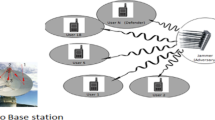Abstract
Existing studies on pilot contamination attack often assume that the attack and jamming strategies of adversaries are fixed. The enemy has not made any strategic corrections to the detection plan. In this paper, we analyze how an intelligent malicious user considers the role of legitimate user and adjusts attacking strategy during training phase in wireless communication to improve his eavesdropping performance. By defender-attacker interaction as a Stackelberg game, Bob as the leader chooses his pilot training power, while a full-duplex eavesdropper as the follower determines the pilot contamination power according to the observed Bob’s ongoing training signals transmission. Two equilibriums under different strategy spaces are analyzed. Simulation results show that the proposed scheme can defend against an intelligent active eavesdropper with a higher secrecy rate and utility.








Similar content being viewed by others
Data Availability
can be made public.
References
Huang K, Wang H (2021) Intelligent reflecting surface aided pilot contamination attack and its countermeasure. IEEE Trans Wirel Commun 20:345–359
Gao H, Liu C, Yin Y, Xu Y, Li Y (2021) A hybrid approach to trust node assessment and management for VANETs Cooperative Data communication: Historical interaction perspective. IEEE Intelligent Transportation Systems Transactions
Zhou X, Maham B, Hjorungnes A (2012) Pilot contamination for active eavesdropping. IEEE Trans Wirel Commun 11(3):903–907
Kapetanovic D, Zheng G, Wong K-K, Ottersten B (2013) Detection of pilot contamination attack using random training and massive MIMO. international symposium on personal. Indoor, and Mobile Radio Communications U.K
Xie J, Liang Y-C, Fang J, Kang X (2017) Two-stage uplink training for pilot spoofing attack detection and secure transmission, IEEE International Conference on Communications France
Xiong Q, Liang Y-C, Li K H, Gong Y, Han S (2016) Secure transmission against pilot spoofing attack: a two-way training-based scheme. IEEE Transactions on Information Forensics and Security 11 (5):1017–1026
Im H, Jeon J, Choi J (2015) Ha, Secret key agreement with large antenna arrays under the pilot contamination attack. IEEE Trans Wirel Commun 14(12):6579–6594
Bai F, Ren P, Du Q, Sun L (2016) A hybrid channel estimation strategy against pilot spoofing attack in MISO system, International Symposium on Personal. Indoor, and Mobile Radio Communications, Spain
Ma X, Xu H, Gao H, Bian M (2021) Real-time multiple-workflow scheduling in cloud environments. IEEE Transactions on Network and Service Management(TNSM) 18(4):4002–4018
Gao H, Zhang Y, Miao H, Duran Barroso Ramon J, Yang X (2021) SDTIOA: modeling the timed privacy requirements of IoT service composition: A User Interaction Perspective for Automatic Transformation from BPEL to Timed Automata ACM/springer Mobile Networks and Applications (MONET)
Yin Y, Huang Q, Gao H, Xu Y (2021) Personalized APIs recommendation with cognitive knowledge mining for industrial systems. IEEE Transactions on Industrial Informatics 17(9):6153–6161
Huang Y, Xu H, Gao H, Hussain, Walayat (2021) SSUR: an approach to optimizing virtual machine allocation strategy based on user requirements for cloud data center. IEEE Transactions on Green Communications and Networking 5(2):670–681
Funding
This work (correspondence author: Yichen Wang) was supported in part by the National Natural Science Foundation of China under Grant 61871314, in part by the Fundamental Research Plan under Grant JCKY2021205B075, and in part by the Key Research and Development Program of Shaanxi Province under Grant 2019ZDLGY07-04.
Author information
Authors and Affiliations
Corresponding author
Ethics declarations
Financial interests
Author Yichen Wang has received research support from the National Natural Science Foundation of China. Author Zhangnan Wang has received research funding from Xi’an Jiaotong University.
Additional information
Publisher’s Note
Springer Nature remains neutral with regard to jurisdictional claims in published maps and institutional affiliations.
Rights and permissions
Springer Nature or its licensor holds exclusive rights to this article under a publishing agreement with the author(s) or other rightsholder(s); author self-archiving of the accepted manuscript version of this article is solely governed by the terms of such publishing agreement and applicable law.
About this article
Cite this article
Wang, Z., Wang, Y. An Intelligent Pilot Contamination Attacker-Defender Model for Wireless Networks: A Stackelberg Game Based Approach. Mobile Netw Appl 27, 2163–2169 (2022). https://doi.org/10.1007/s11036-022-02012-7
Accepted:
Published:
Issue Date:
DOI: https://doi.org/10.1007/s11036-022-02012-7




